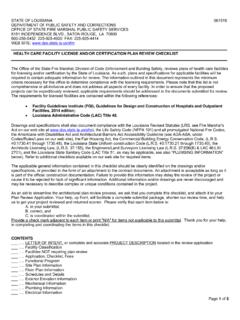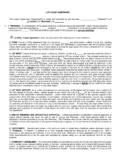Transcription of National Fire Incident Reporting System Complete Reference ...
1 NFIRS Complete Reference GUIDE3-21 CHAPTER 3 BASIC MODULE (NFIRS-1)The P denotes a required C Incident Type P * Incident Type was known as Type of Situation Found in NFIRS is the actual situation that emergency personnel found on the scene when they arrived. These codes include the entire spectrum of fire department activities from fires to EMS to public service. *The type of Incident reported here is not always the same as the Incident type initially dispatched. PurposeThis critical information identifies the various types of incidents to which the fire department responds and allows the fire department to document the full range of incidents it handles. This information can be used to analyze the frequency of different types of incidents, provide insight on fire and other Incident problems, and identify training needs. *This element determines which modules will subsequently be the three-digit code and a written description that best describes the type of Incident .
2 This entry is generally the type of Incident found when emergency personnel arrived at the scene, but if a more seri-ous condition developed after the fire department arrival on the scene, then that Incident type should be reported. The codes are organized in a series:SERIESHEADING100 Fire200 Overpressure Rupture, Explosion, Overheat (No Fire)300 Rescue and Emergency Medical Service (EMS) Incidents400 Hazardous Condition (No Fire)500 Service Call600 Good Intent Call700 False Alarm and False Call800 Severe Weather and Natural Disaster900 Special Incident Type *For incidents involving fire and hazardous materials or fire and EMS, use the fire codes. Always use the lowest numbered series that applies to the Incident . You will have an opportunity to describe multiple actions taken later in the report. *For vehicle fires on a structure, use the mobile property fire codes (130 138) unless the structure be-came NFIRS Complete Reference GUIDECHAPTER 3 BASIC MODULE (NFIRS-1)The P denotes a required *For fires in buildings that are confined to noncombustible containers, use codes 113 118 of the struc-ture fire codes when there is no flame damage beyond the noncombustible in food on the stove that was confined to the pot (113).
3 CIncident Type 131 Food on the stoveIncident TypeINCIDENT TYPE CODESFire. Includes fires out on arrival and gas vapor explosions (with extremely rapid combustion). Structure fire111 Building fire. Excludes confined fires (113 118).112 Fire in structure, other than in a building. Included are fires on or in piers, quays, or pilings: tunnels or under- ground connecting structures; bridges, trestles, or overhead elevated structures; transformers, power or utility vaults or equipment; fences; and Cooking fire involving the contents of a cooking vessel without fire extension beyond the Chimney or flue fire originating in and confined to a chimney or flue. Excludes fires that extend beyond the chimney (111 or 112).115 Incinerator overload or malfunction, but flames cause no damage outside the Fuel burner/boiler, delayed ignition or malfunction, where flames cause no damage outside the fire Commercial compactor fire, confined to contents of compactor.
4 Excluded are home trash Trash or rubbish fire in a structure, with no flame damage to structure or its contents. Fire in mobile property used as a fixed structure. Includes mobile homes, motor homes, camping Fire in mobile home used as a fixed residence. Includes mobile homes when not in transit and used as a structure for residential purposes; and manufactured homes built on a permanent Fire in a motor home, camper, or recreational vehicle when used as a structure. Includes motor homes when not in transit and used as a structure for residential Fire in a portable building, when used at a fixed location. Includes portable buildings used for commerce, industry, or education and trailers used for commercial Fire in mobile property used as a fixed structure, other. Mobile property (vehicle) fire. Excludes mobile properties used as a structure (120 series).
5 If a vehicle fire occurs on a bridge and does not damage the bridge, it should be classified as a vehicle Passenger vehicle fire. Includes any motorized passenger vehicle, other than a motor home (136) ( , pickup trucks, sport utility vehicles, buses).132 Road freight or transport vehicle fire. Includes commercial freight hauling vehicles and contractor vans or trucks. Examples are moving trucks, plumber vans, and delivery Rail vehicle fire. Includes all rail cars, including intermodal containers and passenger cars that are mounted on a rail Water vehicle fire. Includes boats, barges, hovercraft, and all other vehicles designed for navigation on Aircraft fire. Includes fires originating in or on an aircraft, regardless of Self-propelled motor home or recreational vehicle. Includes only self-propelled motor homes or recreational vehicles when being used in a transport mode.
6 Excludes those used for normal residential use (122).137 Camper or recreational vehicle (RV) fire, not self-propelled. Includes trailers. Excludes RVs on blocks or used regularly as a fixed building (122) and the vehicle towing the camper or RV or the campers mounted on pick ups (131). NFIRS Complete Reference GUIDE3-23 CHAPTER 3 BASIC MODULE (NFIRS-1)The P denotes a required Off-road vehicle or heavy equipment fire. Includes dirt bikes, specialty off-road vehicles, earth-moving equip- ment (bulldozers), and farm Mobile property (vehicle) fire, other. Natural vegetation fire. Excludes crops or plants under cultivation (see 170 series).141 Forest, woods, or wildland fire. Includes fires involving vegetative fuels, other than prescribed fire (632), that occur in an area in which development is essentially nonexistent, except for roads, railroads, power lines, and the like.
7 Also includes forests managed for lumber production and fires involving elevated fuels such as tree branches and crowns. Excludes areas in cultivation for agricultural purposes such as tree farms or crops (17x series).142 Brush or brush-and-grass mixture fire. Includes ground fuels lying on or immediately above the ground such as duff, roots, dead leaves, fine dead wood, and downed Grass fire. Includes fire confined to area characterized by grass ground cover, with little or no involvement of other ground fuels; otherwise, see Natural vegetation fire, other. Outside rubbish fire. Includes all rubbish fires outside a structure or Outside rubbish, trash, or waste fire not included in 152 155. Excludes outside rubbish fires in a container or receptacle (154).152 Garbage dump or sanitary landfill Construction or demolition landfill Dumpster or other outside trash receptacle fire.
8 Includes waste material from manufacturing or other produc- tion processes. Excludes materials that are not rubbish or have salvage value (161 or 162).155 Outside stationary compactor or compacted trash fire. Includes fires where the only material burning is rub- bish. Excludes fires where the compactor is damaged (162).150 Outside rubbish fire, other. Special outside fire. Includes outside fires with definable value. Excludes crops and orchards (170 series).161 Outside storage fire on residential or commercial/industrial property, not rubbish. Includes recyclable materi- als at dropoff Outside equipment fire. Includes outside trash compactors, outside HVAC units, and irrigation pumps. Ex- cludes special structures (110 series) and mobile construction equipment (130 series).163 Outside gas or vapor combustion explosion without sustained Outside mailbox fire.
9 Includes dropoff boxes for delivery Special outside fire, other. Cultivated vegetation, crop fire171 Cultivated grain or crop fire. Includes fires involving corn, wheat, soybeans, rice, and other plants before har- Cultivated orchard or vineyard Cultivated trees or nursery stock fire. Includes fires involving Christmas tree farms and plants under cultivation for transport off-site for ornamental Cultivated vegetation, crop fire, other. Fire, other100 Fire, Rupture, Explosion, Overheat (No Fire). Excludes steam mistaken for smoke. Overpressure rupture from steam (no ensuing fire)211 Overpressure rupture of steam pipe or Overpressure rupture of steam Overpressure rupture of pressure or process vessel from Overpressure rupture from steam, other. Overpressure rupture from air or gas (no ensuing fire). Excludes steam or water Overpressure rupture of air or gas pipe or Overpressure rupture of boiler from air or gas.
10 Excludes steam-related overpressure NFIRS Complete Reference GUIDECHAPTER 3 BASIC MODULE (NFIRS-1)The P denotes a required Overpressure rupture of pressure or process vessel from air or gas, not Overpressure rupture from air or gas, other. Overpressure rupture from chemical reaction (no ensuing fire)231 Overpressure rupture of pressure or process vessel from a chemical reaction. Explosion (no fire)241 Munitions or bomb explosion (no fire). Includes explosions involving military ordnance, dynamite, nitroglyc- erin, plastic explosives, propellants, and similar agents with a UN classification or Includes primary and secondary high Blasting agent explosion (no fire). Includes ammonium nitrate and fuel oil (ANFO) mixtures and explosives with a UN Classification (also known as blasting agents).243 Fireworks explosion (no fire).


